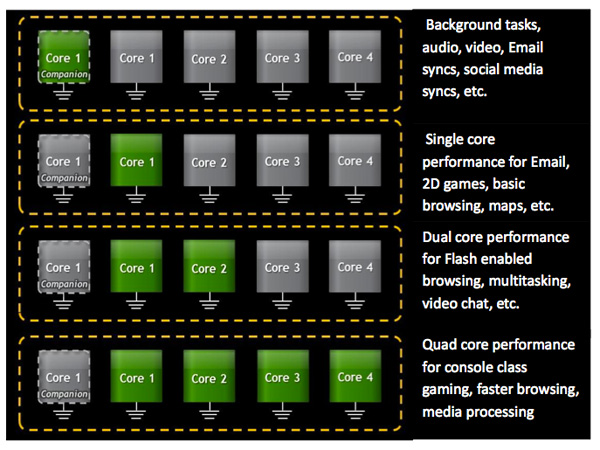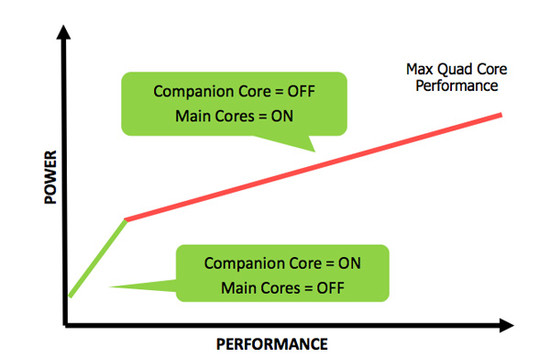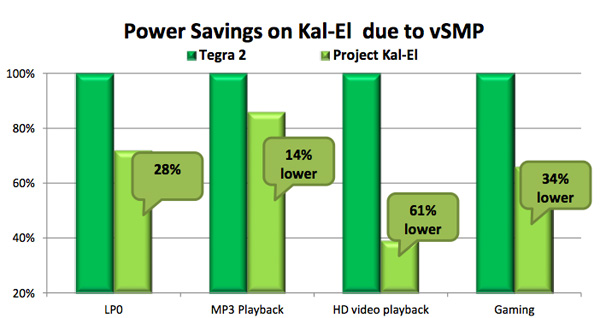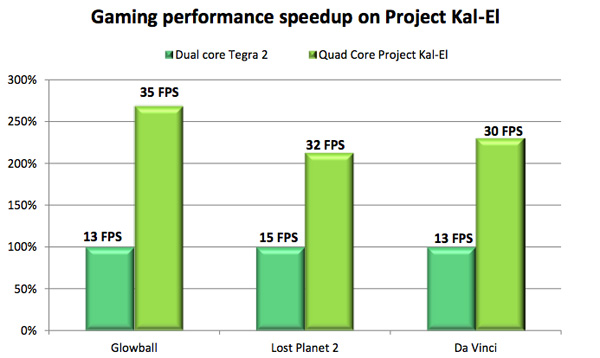Last week a new roadmap for NVIDIA Tegra appeared, and it revealed that Kal-El+, will either be a model with somewhat higher frequencies or a shrink to 28nm. What we did not know about Kal-El is that it will not bring four cores to the game, but five for lower energy consumption.
NVIDIA’s Kal-El will be the market’s first quad-core – or even penta-core – ARM SoC, and by the looks of it the only one on 40nm. The die size is 80mm2, which is ~60% larger than Tegra 2, while still being ~30% smaller than Apple’s A5 (iPad 2 and iPhone 5). The cores are based on ARM’s Cortex A9 architecture, and while the clock frequencies are still unknown they will be higher than with Tegra 2 says NVIDIA.

 So what about this fifth core, and not four that NVIDIA has been boasting. The design counts as a quad-core model, with an extra companion since not all five cores will be active at the same time. The fifth cores uses LP transistors (Low Power), with very little leakage, but also capable of not so high frequencies. The rest of the SoC is built on regular GP transistors (General Purpose) that can do higher clocks, nothing weird about that.
So what about this fifth core, and not four that NVIDIA has been boasting. The design counts as a quad-core model, with an extra companion since not all five cores will be active at the same time. The fifth cores uses LP transistors (Low Power), with very little leakage, but also capable of not so high frequencies. The rest of the SoC is built on regular GP transistors (General Purpose) that can do higher clocks, nothing weird about that.
The fifth core will only be used for generic background applications, like when the phone is in standby, and during lighter use. It is based on the same architecture as the rest of the cores, but use a different kind of transistors and will thus be clocked lower at only 500 MHz.
 The point of a fifth core is to let it do the less demanding tasks, like playing music, watching movies, synchronizing events and social media, etc. As soon as more power is needed the Spartan core will be closed down, to let the more able cores do the job. The best is that the operating system is not involved but everything is done in the hardware. No software support needed. NVIDIA’s 4+1 solution is called vSMP. We still feel that Kal-El counts as a quad-core SoC, since there will never be five active cores.
The point of a fifth core is to let it do the less demanding tasks, like playing music, watching movies, synchronizing events and social media, etc. As soon as more power is needed the Spartan core will be closed down, to let the more able cores do the job. The best is that the operating system is not involved but everything is done in the hardware. No software support needed. NVIDIA’s 4+1 solution is called vSMP. We still feel that Kal-El counts as a quad-core SoC, since there will never be five active cores.

 We have earlier reported that Kal-El will consume less energy than Tegra 2, despite the higher specifications. Said and done, NVIDIA has released a diagram whosing savings between 14 – 61 % over Tegra 2.
We have earlier reported that Kal-El will consume less energy than Tegra 2, despite the higher specifications. Said and done, NVIDIA has released a diagram whosing savings between 14 – 61 % over Tegra 2.
 Kal-El will bring12 graphics cores over the previous 8, but thanks to a new base architecture it will be 2 – 3 times faster than Tegra 2. This diagram shows exactly that, and its claims seem to add up, but bear in mind these tests were done by NVIDIA.
Kal-El will bring12 graphics cores over the previous 8, but thanks to a new base architecture it will be 2 – 3 times faster than Tegra 2. This diagram shows exactly that, and its claims seem to add up, but bear in mind these tests were done by NVIDIA.
Kal-El looks just as interesting as Tegra 2 when it arrived. Large portions of Tegra 2’s success was because Google picked it as the reference platform for Android 3.0 ”Honeycomb”. With the launch of Android 4.0 ”Ice Cream Sandwich” Texas Instruments has the ball and its OMAP was given the role of reference. NVIDIA still has many customers after Tegra 2, but it will not be going as easily as before as it now has to present its product as the superior one, against Google recommendations.

Kal-El will be the sole quad-core SoC at 40nm, and it will take at least 4 – 6 months before there is an equal SoC from actors like Qualcomm and Texas Instruments. The company has a headstart if it can keep the energy conumption down, which it seems to have solved with even more cores, instead of fewer.
Source: NVIDIA




